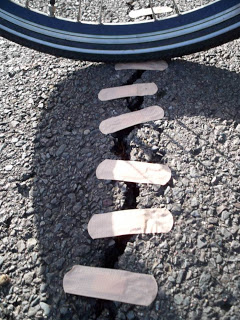 The modern day plague of potholes may have just met its match. Erik Schlangen and his cohorts at the Delft University of Technology in the Netherlands have come up with a self-healing asphalt. They’re taking porous asphalt with its advantages of having splash water drain right through and noise dampening properties, and addressing the problem of revelling or stones at the surface sloughing off leading to cracks and potholes. To solve this issue they are adding steel fibers to the aggregate binding material. When the binding material does become damaged due to weathering, oxidation or uv light the steel can be heated with an induction machine which will melt the bitumen that then flows into microcracks so that the stones become fixed to the surface again. They estimate the road needs to be “healed” about every four years or so and this supposedly will double the life of the asphalt. I’ve got a nice little stretch of road in front of my house that they can use as a test patch any time they want.
The modern day plague of potholes may have just met its match. Erik Schlangen and his cohorts at the Delft University of Technology in the Netherlands have come up with a self-healing asphalt. They’re taking porous asphalt with its advantages of having splash water drain right through and noise dampening properties, and addressing the problem of revelling or stones at the surface sloughing off leading to cracks and potholes. To solve this issue they are adding steel fibers to the aggregate binding material. When the binding material does become damaged due to weathering, oxidation or uv light the steel can be heated with an induction machine which will melt the bitumen that then flows into microcracks so that the stones become fixed to the surface again. They estimate the road needs to be “healed” about every four years or so and this supposedly will double the life of the asphalt. I’ve got a nice little stretch of road in front of my house that they can use as a test patch any time they want.
What about concrete you say? There is news on that front too and it’s called Bio-Concrete. The same people who are working with self-healing asphalt have come up with a way to add bacteria to concrete which allows the spores to lie dormant until awakened by moisture and oxygen when a crack appears. The bacteria spores along with calcium nutrients are encapsulated in pellet or granular form and added to a wet concrete mix. Years later when cracks form and water reaches the pellets they open up allowing the bacteria to germinate and to feed on the nutrients which in turn allows them to multiply and produce limestone which ultimately fills in the holes. It’s like Pac-Man in reverse. This is just in the testing stage right now but I wonder what would happen if these little bugs got loose somehow. Maybe they should figure out some kind of food the bacteria wouldn’t like and keep a supply on hand for just in case. I vote they try brussels sprouts.
[Update 04/01/13: Just came across a story about self-healing microchips. To demonstrate how it works, they shot a series of laser pulses at a chip carrying 100,000 transistors which fried about half the circuits. Within less than a second, the chip had already re-routed everything to make itself functional again. What do you think about that Sarah Connor?]
